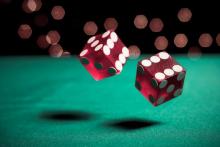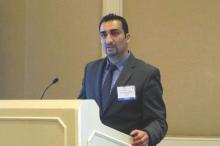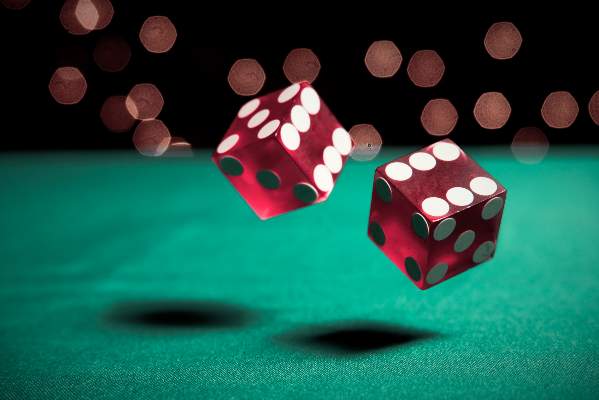User login
AVENTURA, FLA. – People with unrecognized gambling disorders may present with depression, anxiety, substance abuse, or other psychiatric symptoms, and screening patients with these symptoms can help make this connection, Dr. Timothy Fong said during a workshop at the annual meeting of the American Academy of Addiction Psychiatry.
Screening tools are essential in helping identify patients with a gambling disorder or subthreshold disorder, who typically do not bring up these problems with their physicians and often suffer in private, said Dr. Fong, a psychiatrist at the University of California, Los Angeles, and codirector of the UCLA Gambling Studies Program.
“By the time I see them, the screening has already happened; they have self-identified as having a problem,” he pointed out. “But when they’re coming to see the general psychiatrist,” problems like depression, difficulty sleeping, or problems with a spouse or family, “are the chief complaints, it’s not ‘I have a gambling problem.’ ”
Screening can help identify patients before they develop a full-blown gambling disorder, at an earlier stage, when it is simpler to treat and interventions are more effective “and you can prevent the progression to a more severe disorder,” he noted.
Another sign someone might have a gambling problem is failure to respond to medication, an indication that problem gambling “may be a hidden addiction that is driving the stress [or] depression,” Dr. Fong said, citing a patient with depression who does not respond to courses of selective serotonin reuptake inhibitors or other categories of antidepressants as an example.
During a workshop on gambling disorders held during the meeting, Dr. Fong and Dr. Iman Parhami, who is affiliated with the Delaware Division of Substance Abuse and Mental Health, New Castle, Del., referred to one such resource, a brief three-question screening tool available on the National Center for Responsible Gaming website.
Gambling behavior can be considered in three levels, recreational gambling, where there are no repercussions related to gambling; subthreshold gambling disorder, where the individual encounters gambling-related problems but does not meet the diagnostic threshold for a disorder, although is at an increased risk of developing a gambling disorder at some point in the future; and gambling disorder. A gambling disorder is characterized by “persistent, recurring and sometimes progressive maladaptive gambling behavior despite the negative consequences,” with behavior that has the greatest social, psychological, and medical impact. Those with a subthreshold gambling disorder are at a higher risk, but whether recreational gamblers are at increased risk is less clear, said Dr. Parhami, who formerly was affiliated with the UCLA gambling studies program.
In the DSM-5, gambling disorder now appears under “non substance-related disorders” in the substance-related and addictive disorders section, and is defined as “persistent and recurrent problematic gambling behavior leading to clinically significant impairment or distress,” as indicated by the individual exhibiting at least four of nine symptoms over a 12-month period: preoccupation, tolerance, withdrawal (developing symptoms like anxiety when they do not gamble), loss of control, escapism, dishonesty, risk-taking behaviors related to gambling, chasing (returning another day to get even after losing money gambling), and bailouts (relying on others to provide money to relieve a desperate financial situation caused by gambling). These symptoms are similar to other addictive disorders, and loss of control is probably the main symptom, Dr. Parhami said.
Identifying a patient with a gambling disorder at an earlier stage and preventing progression also can reduce the risk of developing a comorbid disorder, because any level of gambling is associated with an increased risk for developing comorbid mental disorders, according to Dr. Parhami and Dr. Fong, two of the authors of a recently published prospective study, which compared the incidence of new onset comorbid disorders among people at three levels of gambling behavior, to those who did not gamble at all.
Using longitudinal data from the National Epidemiologic Survey on Alcohol and Related Conditions, researchers divided respondents into three groups: those with a gambling disorder, those with a subthreshold gambling disorder, and those who were recreational gamblers. Three years after their initial interview for the survey, those in all three groups were at a statistically significantly increased risk of having any mood, anxiety, or substance abuse disorder, compared with controls who did not gamble at all (J. Psychiatr. Pract. 2014;20:207-19).
Overall, those in the three gambling behavior categories were at a more than twofold greater risk among those with gambling disorder diagnosis at baseline, with an odds ratio – adjusted for age, sex, marital status, annual income, and education – of 2.5. The risk also was significantly increased among those with a subthreshhold gambling disorder at baseline (odds ratio, 1.77) and even among those who were recreational gamblers at baseline (OR, 1.16).
When mood, anxiety, and substance abuse disorders were evaluated separately, a graded or dose-response relationship was found between different levels of gambling and risk, with the risks highest for those with the disorder and lowest for recreational gamblers, and the risk falling in between for the subthreshold gamblers, Dr. Fong said.
The risk of a mood disorder was increased by more than fourfold among those with a gambling disorder at baseline (OR, 4.38), and also was increased among those with a subthreshold gambling disorder at baseline (OR, 1.37). The risk of any anxiety disorder also followed the same pattern, significantly increased among those with a gambling disorder (OR, 3.11), subthreshold disorder (OR, 1.70), and recreational gamblers (OR, 1.10).
The risk of any substance use disorder also was significantly increased at all three levels. Among those with a gambling disorder at baseline, the risks of any alcohol-related disorder and alcohol dependence were increased among those with a gambling disorder at baseline (ORs, 3.90 and 4.66, respectively), and also were increased among those with a subthreshold disorder at baseline (OR, 1.97, 2.19), and among those who were recreational gamblers at baseline (OR 1.3, 1.29).
Dr. Fong and Dr. Parhami had no disclosures relevant to this presentation at the meeting.
AVENTURA, FLA. – People with unrecognized gambling disorders may present with depression, anxiety, substance abuse, or other psychiatric symptoms, and screening patients with these symptoms can help make this connection, Dr. Timothy Fong said during a workshop at the annual meeting of the American Academy of Addiction Psychiatry.
Screening tools are essential in helping identify patients with a gambling disorder or subthreshold disorder, who typically do not bring up these problems with their physicians and often suffer in private, said Dr. Fong, a psychiatrist at the University of California, Los Angeles, and codirector of the UCLA Gambling Studies Program.
“By the time I see them, the screening has already happened; they have self-identified as having a problem,” he pointed out. “But when they’re coming to see the general psychiatrist,” problems like depression, difficulty sleeping, or problems with a spouse or family, “are the chief complaints, it’s not ‘I have a gambling problem.’ ”
Screening can help identify patients before they develop a full-blown gambling disorder, at an earlier stage, when it is simpler to treat and interventions are more effective “and you can prevent the progression to a more severe disorder,” he noted.
Another sign someone might have a gambling problem is failure to respond to medication, an indication that problem gambling “may be a hidden addiction that is driving the stress [or] depression,” Dr. Fong said, citing a patient with depression who does not respond to courses of selective serotonin reuptake inhibitors or other categories of antidepressants as an example.
During a workshop on gambling disorders held during the meeting, Dr. Fong and Dr. Iman Parhami, who is affiliated with the Delaware Division of Substance Abuse and Mental Health, New Castle, Del., referred to one such resource, a brief three-question screening tool available on the National Center for Responsible Gaming website.
Gambling behavior can be considered in three levels, recreational gambling, where there are no repercussions related to gambling; subthreshold gambling disorder, where the individual encounters gambling-related problems but does not meet the diagnostic threshold for a disorder, although is at an increased risk of developing a gambling disorder at some point in the future; and gambling disorder. A gambling disorder is characterized by “persistent, recurring and sometimes progressive maladaptive gambling behavior despite the negative consequences,” with behavior that has the greatest social, psychological, and medical impact. Those with a subthreshold gambling disorder are at a higher risk, but whether recreational gamblers are at increased risk is less clear, said Dr. Parhami, who formerly was affiliated with the UCLA gambling studies program.
In the DSM-5, gambling disorder now appears under “non substance-related disorders” in the substance-related and addictive disorders section, and is defined as “persistent and recurrent problematic gambling behavior leading to clinically significant impairment or distress,” as indicated by the individual exhibiting at least four of nine symptoms over a 12-month period: preoccupation, tolerance, withdrawal (developing symptoms like anxiety when they do not gamble), loss of control, escapism, dishonesty, risk-taking behaviors related to gambling, chasing (returning another day to get even after losing money gambling), and bailouts (relying on others to provide money to relieve a desperate financial situation caused by gambling). These symptoms are similar to other addictive disorders, and loss of control is probably the main symptom, Dr. Parhami said.
Identifying a patient with a gambling disorder at an earlier stage and preventing progression also can reduce the risk of developing a comorbid disorder, because any level of gambling is associated with an increased risk for developing comorbid mental disorders, according to Dr. Parhami and Dr. Fong, two of the authors of a recently published prospective study, which compared the incidence of new onset comorbid disorders among people at three levels of gambling behavior, to those who did not gamble at all.
Using longitudinal data from the National Epidemiologic Survey on Alcohol and Related Conditions, researchers divided respondents into three groups: those with a gambling disorder, those with a subthreshold gambling disorder, and those who were recreational gamblers. Three years after their initial interview for the survey, those in all three groups were at a statistically significantly increased risk of having any mood, anxiety, or substance abuse disorder, compared with controls who did not gamble at all (J. Psychiatr. Pract. 2014;20:207-19).
Overall, those in the three gambling behavior categories were at a more than twofold greater risk among those with gambling disorder diagnosis at baseline, with an odds ratio – adjusted for age, sex, marital status, annual income, and education – of 2.5. The risk also was significantly increased among those with a subthreshhold gambling disorder at baseline (odds ratio, 1.77) and even among those who were recreational gamblers at baseline (OR, 1.16).
When mood, anxiety, and substance abuse disorders were evaluated separately, a graded or dose-response relationship was found between different levels of gambling and risk, with the risks highest for those with the disorder and lowest for recreational gamblers, and the risk falling in between for the subthreshold gamblers, Dr. Fong said.
The risk of a mood disorder was increased by more than fourfold among those with a gambling disorder at baseline (OR, 4.38), and also was increased among those with a subthreshold gambling disorder at baseline (OR, 1.37). The risk of any anxiety disorder also followed the same pattern, significantly increased among those with a gambling disorder (OR, 3.11), subthreshold disorder (OR, 1.70), and recreational gamblers (OR, 1.10).
The risk of any substance use disorder also was significantly increased at all three levels. Among those with a gambling disorder at baseline, the risks of any alcohol-related disorder and alcohol dependence were increased among those with a gambling disorder at baseline (ORs, 3.90 and 4.66, respectively), and also were increased among those with a subthreshold disorder at baseline (OR, 1.97, 2.19), and among those who were recreational gamblers at baseline (OR 1.3, 1.29).
Dr. Fong and Dr. Parhami had no disclosures relevant to this presentation at the meeting.
AVENTURA, FLA. – People with unrecognized gambling disorders may present with depression, anxiety, substance abuse, or other psychiatric symptoms, and screening patients with these symptoms can help make this connection, Dr. Timothy Fong said during a workshop at the annual meeting of the American Academy of Addiction Psychiatry.
Screening tools are essential in helping identify patients with a gambling disorder or subthreshold disorder, who typically do not bring up these problems with their physicians and often suffer in private, said Dr. Fong, a psychiatrist at the University of California, Los Angeles, and codirector of the UCLA Gambling Studies Program.
“By the time I see them, the screening has already happened; they have self-identified as having a problem,” he pointed out. “But when they’re coming to see the general psychiatrist,” problems like depression, difficulty sleeping, or problems with a spouse or family, “are the chief complaints, it’s not ‘I have a gambling problem.’ ”
Screening can help identify patients before they develop a full-blown gambling disorder, at an earlier stage, when it is simpler to treat and interventions are more effective “and you can prevent the progression to a more severe disorder,” he noted.
Another sign someone might have a gambling problem is failure to respond to medication, an indication that problem gambling “may be a hidden addiction that is driving the stress [or] depression,” Dr. Fong said, citing a patient with depression who does not respond to courses of selective serotonin reuptake inhibitors or other categories of antidepressants as an example.
During a workshop on gambling disorders held during the meeting, Dr. Fong and Dr. Iman Parhami, who is affiliated with the Delaware Division of Substance Abuse and Mental Health, New Castle, Del., referred to one such resource, a brief three-question screening tool available on the National Center for Responsible Gaming website.
Gambling behavior can be considered in three levels, recreational gambling, where there are no repercussions related to gambling; subthreshold gambling disorder, where the individual encounters gambling-related problems but does not meet the diagnostic threshold for a disorder, although is at an increased risk of developing a gambling disorder at some point in the future; and gambling disorder. A gambling disorder is characterized by “persistent, recurring and sometimes progressive maladaptive gambling behavior despite the negative consequences,” with behavior that has the greatest social, psychological, and medical impact. Those with a subthreshold gambling disorder are at a higher risk, but whether recreational gamblers are at increased risk is less clear, said Dr. Parhami, who formerly was affiliated with the UCLA gambling studies program.
In the DSM-5, gambling disorder now appears under “non substance-related disorders” in the substance-related and addictive disorders section, and is defined as “persistent and recurrent problematic gambling behavior leading to clinically significant impairment or distress,” as indicated by the individual exhibiting at least four of nine symptoms over a 12-month period: preoccupation, tolerance, withdrawal (developing symptoms like anxiety when they do not gamble), loss of control, escapism, dishonesty, risk-taking behaviors related to gambling, chasing (returning another day to get even after losing money gambling), and bailouts (relying on others to provide money to relieve a desperate financial situation caused by gambling). These symptoms are similar to other addictive disorders, and loss of control is probably the main symptom, Dr. Parhami said.
Identifying a patient with a gambling disorder at an earlier stage and preventing progression also can reduce the risk of developing a comorbid disorder, because any level of gambling is associated with an increased risk for developing comorbid mental disorders, according to Dr. Parhami and Dr. Fong, two of the authors of a recently published prospective study, which compared the incidence of new onset comorbid disorders among people at three levels of gambling behavior, to those who did not gamble at all.
Using longitudinal data from the National Epidemiologic Survey on Alcohol and Related Conditions, researchers divided respondents into three groups: those with a gambling disorder, those with a subthreshold gambling disorder, and those who were recreational gamblers. Three years after their initial interview for the survey, those in all three groups were at a statistically significantly increased risk of having any mood, anxiety, or substance abuse disorder, compared with controls who did not gamble at all (J. Psychiatr. Pract. 2014;20:207-19).
Overall, those in the three gambling behavior categories were at a more than twofold greater risk among those with gambling disorder diagnosis at baseline, with an odds ratio – adjusted for age, sex, marital status, annual income, and education – of 2.5. The risk also was significantly increased among those with a subthreshhold gambling disorder at baseline (odds ratio, 1.77) and even among those who were recreational gamblers at baseline (OR, 1.16).
When mood, anxiety, and substance abuse disorders were evaluated separately, a graded or dose-response relationship was found between different levels of gambling and risk, with the risks highest for those with the disorder and lowest for recreational gamblers, and the risk falling in between for the subthreshold gamblers, Dr. Fong said.
The risk of a mood disorder was increased by more than fourfold among those with a gambling disorder at baseline (OR, 4.38), and also was increased among those with a subthreshold gambling disorder at baseline (OR, 1.37). The risk of any anxiety disorder also followed the same pattern, significantly increased among those with a gambling disorder (OR, 3.11), subthreshold disorder (OR, 1.70), and recreational gamblers (OR, 1.10).
The risk of any substance use disorder also was significantly increased at all three levels. Among those with a gambling disorder at baseline, the risks of any alcohol-related disorder and alcohol dependence were increased among those with a gambling disorder at baseline (ORs, 3.90 and 4.66, respectively), and also were increased among those with a subthreshold disorder at baseline (OR, 1.97, 2.19), and among those who were recreational gamblers at baseline (OR 1.3, 1.29).
Dr. Fong and Dr. Parhami had no disclosures relevant to this presentation at the meeting.
EXPERT ANALYSIS FROM THE AAAP ANNUAL MEETING


